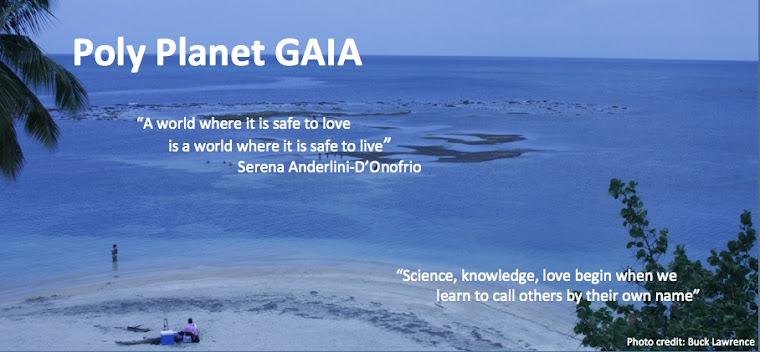Dear Earthlings:
The
EcoSex course at U Conn is in process. It's a great experience. We
are reading amazing books. Thinking out of the box and across
disciplines. Students are sending their responses in, with discussion
questions. In class, we connect the dots: a
holograph of what we've read together, the "required readings."
Multiple perspectives and good synergy. Here, we offer a glimpse.
Serena Anderlini-D'Onofrio's Gaia and the New Politics of Love was one of three cultural theory books. We got four responses: from Michael, Alissa, John, and Alexandra.
Here's Michaels's take:
Response to Serena Anderlini-D'Onofrio's Gaia and the New Politics of Love: Notes for a Poly Planet
In the book’s initial discussion of the
Gaia hypothesis, a comparison is made to Galileo’s discovery of the
heliocentric solar system and the discovery’s role in helping to reshape the
dogma of the scientific community. I found this comparison, particularly with
the references to the works of Thomas Kuhn and Ludwik Fleck very interesting
because I think this is certainly a problem that science has never really been
able to avoid. I think there’s evidence of this within every generation, as
seen with Einstein’s rejection of quantum mechanics because of his belief that
the universe couldn’t be so random.
In addition to the scientific community’s
ability to become rooted in dogma, I think an additional problem has a risen
vis-à-vis how the proliferation of modern media has encouraged such bad
behavior among scientists. While such paradigm shifts are often generational,
there is now also an element that every discovery is amplified and given
significance beyond its actual findings. This makes it that much harder to
shift the paradigm because public perception and its bias has been added to the
field in addition to the biases of the scientists themselves.
I also found the discussion of abortion
rights and the religion’s role interesting. As a supporter of abortion I had
always thought of it in the manner described in the book as supporting the
principle but simultaneously wanting to avoid it happening still. I had never
really thought about why this might be problematic in a different way from a
fundamentally pro-life perspective and am glad this was raised by the book.
Does
the use of Gaia Theory as a philosophy behind changing human society
necessitate the acknowledgement that human-centric thinking as being top of the
‘food chain’ must be abandoned?
Michael Maranets
Published with permission
WGSS 3998 - Ecosexuality and the Ecology of Love
Prof. Serena Anderlini-D'Onofrio
U Conn, Storrs, Spring 2013
Dear Earthlings:
Let "nature" be your teacher in the arts of love. Education is the heart of democracy, education to love. Come
back for more wonders: Students Responses to appear every Tuesday.
Book Reports to be scheduled soon, every other Thursday. Check out our summer offerings: Ecosexuality in Portland, OR, July 17-21. Info and Registration here!
Namaste,
Serena Anderlini-D'Onofrio, PhD
Gilf Gaia Extraordinaire
University of Puerto Rico, Mayaguez
Follow us in the social media
Poly Planet GAIA Blog:
http://polyplanet.blogspot.
http://polyplanet.blogspot.
Website: www.serenagaia.com
Be Appraised of Ecosex Community Project PostaHouse
Become a Fan: www.facebook.com/GaiaBlessings
Author's Page/Lists all books:
YouTube Uploaded Videos: http://www.youtube.com/












